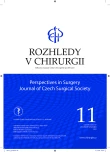Early surgical and vascular complications after open repairs of aortoiliac aneurysms
Authors:
M. Pirkl 1,2; F. Krampota 1; T. Daněk 1; Michal Černý 1
Authors‘ workplace:
Oddělení cévní a plastické chirurgie, Chirurgická klinika, Pardubická nemocnice, NPK, a. s.
1; Fakulta zdravotnických studií, Univerzita Pardubice
2
Published in:
Rozhl. Chir., 2018, roč. 97, č. 11, s. 499-503.
Category:
Original articles
Overview
Introduction:
The surgical procedures due to aortoiliac aneurysm (AAA) represent the most demanding procedures in conventional vascular surgery. This is due, among other things, to the relatively frequent systemic and surgical complications in polymorbid and often urgently operated patients. Surgical and vascular complications after resections of aortoiliac aneurysms are relatively common, and reintervention due to these complications is reported to range around 14%.
Method:
Retrospective clinical study of a group of patients undergoing surgical management for aortoiliac aneurysms in the period from 1 January 2010 to 31 December 2017 at the Department of Vascular and Plastic Surgery of Pardubice Hospital NPK.
Results:
In a group of 240 patients (205 males, 35 females), mortality reached a total of 10.4%, with mortality in elective cases 3.4% and 31.1% in urgent procedures (37.5% in AAA rupture). Overall, in the elective group, we recorded a total of 29 (16.2%) surgical and/or vascular complications with the necessity of 16 (8.9%) surgical, endovascular or combined interventions. In the emergency group, these complications were recorded 30 times (49%) with the need for intervention in 19 cases (31.1% of emergency procedures).
Conclusion:
Open surgical procedures on AAA are accompanied by a high incidence of systemic and surgical and/or vascular complications. These patients therefore require high attention and quality of intensive care in the postoperative period, focusing on early diagnosis and subsequent treatment of these complications.
Key words:
aortoiliac aneurysm − surgical complications – bleeding − limb ischemia − abdominal compartment syndrome
Sources
- Opatrný V, Třeška V, Moláček J, et al. Gigantické aneuryzma abdominální aorty a pánevních tepen. Rozhl Chir 2016;95 : 123−5.
- Kieffer WKM, Sonnenberg S, Windhaber RA, et al. Complications and reintervention following elective open abdominal aortic aneurysm repair: a 10-year retrospective analysis. Ann R Coll Surg Engl 2012; 94 : 177–80.
- Motte L, Jensen LP, Vogt K, et al. Outcomes after elective aortic aneurysm repair: A nationwide Danish cohort study 2007−2010. Eur J Vasc Endovasc Surg 2013;46 : 57−64.
- Trenner M, Kuehnl A, Salvermoser M, et al. Editor´s choice – High annual hospital volume is associated with decreased in hospital mortality and complication rates following treatment of abdominal aortic aneurysm: Secondary data analysis of the nationwide German DRG statistics from 2005–2013. Eur J Vasc Endovasc Surg 2018;55 : 185−94.
- Woo YE, Damrauer SM. Abdominal aortic aneurysms: Open surgical treatment. In: Cronenwett JL, Johnston KW, et al. Rutherford´s vascular surgery. 8th edition. Elsevier Saunders 2014 : 2025−45.
- Mehta M, Byrne J. Abdominal aortic aneurysms: ruptured. In: Cronenwett JL, Johnston KW, et al. Rutherford´s vascular surgery. 8th edition. Elsevier Saunders 2014 : 2063−82.
- Toursavadkohi S, Stavros Kakkos SK, Rubinfeld I,et al. Lower extremity microembolism in open vs. endovascular abdominal aortic aneurysm repair. Front Surg 2016;3 : 1−5.
- Marin ML, Veith FJ, Cynamon J, et al. Initial experience with transluminally placed endovascular grafts for the treatment of complex vascular lesions. Ann Surg 1995,222 : 449–69.
- Maldonado TS, Rockman C, Riles TS. Ischemic complications after endo-vascular abdominal aortic aneurysm repair. J Vasc Surg 2004;40 : 703–9.
- Gerhart CD, Nicholas GG, Reed JF. Predictive model for colonic ischemia following abdominal aortic aneurysm repair. Vasc Endovas Surg 1994;28 : 161–6.
- Pirkl M, Daněk T, Šebesta P, et al. Neokluzivní ischemická kolitida po resekci aneuryzmatu abdominální aorty: zkušenosti z našeho pracoviště a shrnutí problematiky. Slov chir 2012;9 : 102–10.
- Menegaux F, Trésallet Ch, Kieffer E, et al. Aggressive management of nonocclusive ischemic colitis following aortic aeconstruction. Arch Surg 2006;141 : 678–82.
- Bozeman MC, B. Ross CB. Intra-abdominal hypertension and abdominal compartment syndrome in association with ruptured abdominal aortic aneurysm in the endovascular era: Vigilance remains critical. Crit Care Res Pract 2012. Available from: doi:10.1155/2012/151650
- WSACS Consensus Guidelines Summary. Available from: http:/www.wsacs.org.
- Moll FL, Powell JT, Fraedrich G, et al. Management of abdominal aortic aneurysms clinical practice guidelines of the European society for vascular surgery. Eur J Vasc Endovasc Surg 2011;41:S1−S58.
- Rasmussen TE, Hallett JW, Noel AA, et al. Early abdominal closure with mesh reduces multiple organ failure after ruptured abdominal aortic aneurysm repair: guidelines from a 10-year case-control study. J Vasc Surg 2002;35 : 246–52.
- Ross CB, Irwin CL, Mukherjee K, et al. Vacuum-pack temporary abdominal wound management with delayed-closure for the management of ruptured abdominal aortic aneurysm and other abdominal vascular catastrophes: absence of graft infection in long-term survivors. Am Surg 2009;75 : 565–70.
Labels
Surgery Orthopaedics Trauma surgeryArticle was published in
Perspectives in Surgery

2018 Issue 11
Most read in this issue
- Dunbar syndrome – single-center experience with surgical treatment
- Hypogastric artery aneurysm – a case report
- Trauma of the extracranial cerebral arteries due to injuries of the cervical spine
- Indications to open surgical revascularization of visceral arteries in the endovascular era
